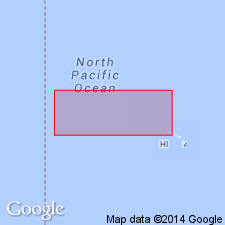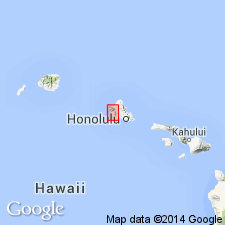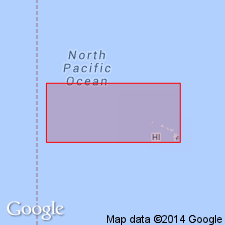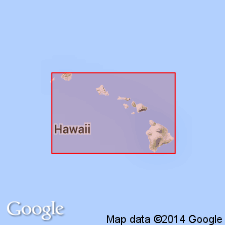
- Usage in publication:
-
- Hawaiiloa volcanics*
- Modifications:
-
- Named
- Dominant lithology:
-
- Basalt
- AAPG geologic province:
-
- Oahu
Summary:
Named for occurrence at Puu Hawaiiloa, cinder cone on northwest corner of Mokapu Peninsula [Mokapu 7.5' quad] Island of Oahu. Formerly informally called "Puu Hawaiiloa agglomerate and lava series" by Wentworth (1926). Composed of nepheline-basalt with flows more than 100 ft thick and cinder cone 337 ft high. Included as unit in lower part of Honolulu volcanic series. Unconformably underlies Ulupau tuff. On basis of relationship to Ulupau and Kaena stand of sea, assigned middle(?) and late Pleistocene age.
Source: GNU records (USGS DDS-6; Menlo GNULEX).

- Usage in publication:
-
- Hawaiiloa volcanics*
- Modifications:
-
- Revised
- AAPG geologic province:
-
- Oahu
Summary:
Pyramid Rock was reexamined for evidence of vent and separate flow [from Hawaiiloa volcanics]. Rocks of Pyramid Rock basalt (new) were found to differ in texture from Hawaiiloa volcanics (G.A. Macdonald, pers. commun., May 1940) [and therefore no longer included in Hawaiiloa volcanics].
Source: GNU records (USGS DDS-6; Menlo GNULEX).

- Usage in publication:
-
- Hawaiiloa volcanics*
- Modifications:
-
- Age modified
- AAPG geologic province:
-
- Oahu
Summary:
Covers about 0.75 sq mi on west part of Mokapu Peninsula on northeast coast of Oahu about 13 mi northwest of Makapuu Head. No fossils. Because unit underlies Ulupau tuff and apparent wave-cut terraces at 100 and 65 ft altitude on Puu Hawaiiloa, eruption is believed to have occurred during minus 300-foot (Kahipa) stand of sea. Assigned Pleistocene age.
Source: GNU records (USGS DDS-6; Menlo GNULEX).

- Usage in publication:
-
- Hawaiiloa Volcanics*
- Modifications:
-
- Geochronologic dating
- AAPG geologic province:
-
- Oahu
Summary:
K-Ar ages on basalt from Puu Hawaiiloa vent ranges from 14.3 +/-2.34 to 6.05 +/-1.86 Ma. "The ages for Puu Hawaiiloa (vent 1) and Ainoni (vent 20) are older than the lower age limit of about 1.8 m.y. for the underlying Koolau Volcanic Series. These anomalously old ages and the poor reproducibility in argon measurements indicate the samples contain excess radiogenic Ar-40 that is heterogeneously distributed." p.743
Source: GNU records (USGS DDS-6; Menlo GNULEX).

- Usage in publication:
-
- Hawaiiloa Volcanics†
- Modifications:
-
- Abandoned
- AAPG geologic province:
-
- Oahu
Summary:
Hawaiiloa Volcanics (Stearns, IN Stearns and Vaksvik, 1935) abandoned as formally named unit and called Hawaiiloa flow (and associated cone), informal unit of Honolulu Volcanics.
Source: GNU records (USGS DDS-6; Menlo GNULEX).
For more information, please contact Nancy Stamm, Geologic Names Committee Secretary.
Asterisk (*) indicates published by U.S. Geological Survey authors.
"No current usage" (†) implies that a name has been abandoned or has fallen into disuse. Former usage and, if known, replacement name given in parentheses ( ).
Slash (/) indicates name conflicts with nomenclatural guidelines (CSN, 1933; ACSN, 1961, 1970; NACSN, 1983, 2005, 2021). May be explained within brackets ([ ]).

